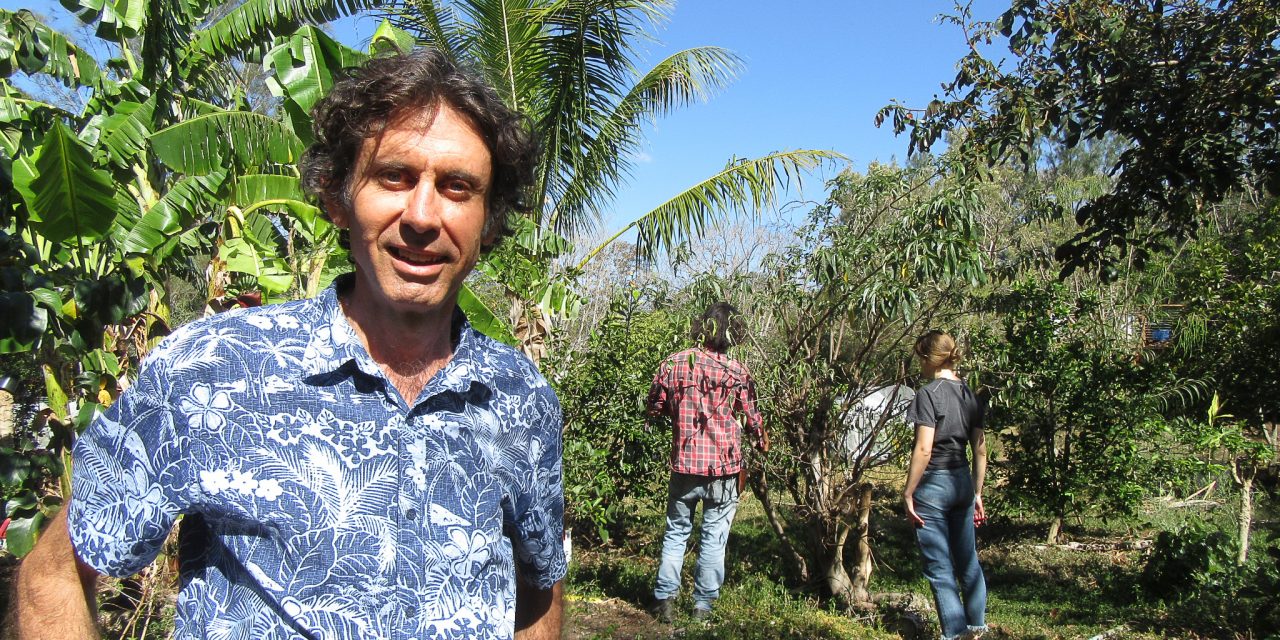At the end of 2020, local landscape architect, Gavin Hardy, was thrilled to learn that he is a recipient of a prestigious Churchill Fellowship.
Many will know Gavin locally from his work on green space initiatives including the Kurilpa Green Space Strategy (a 2016 national landscape architecture award winner), Northey Street City Farm, and Main Street Boulevard.
The aim of the Churchill Fellowship is to provide an opportunity to Australians to travel overseas to conduct research in their chosen field. Gavin will be studying two special types of green space:
- Community-based food forests (assemblies of food producing trees, shrubs, groundcovers, and vines that mimic natural forests); and
- Community orchards (large and orderly groves of fruit and nut trees on pasture)
Gavin says food forestry has been practised for centuries.
“It mimics the way a natural forest works in structure. So, think about a forest having an upper canopy of tall trees, then some mid-storey trees and shrubs, herbage, ground covers, and vines. That’s the basic structure of a forest. In a food forest most of the plants yield food and fibre for people. It’s a form of agroforestry.”
Gavin says that scientific inquiry into agroforestry really got started in the 1970’s by researcher P.K Nair who was looking at multistorey tree cropping systems in Kerala, India to understand how to apply them in the modern context.
“It is considered one of the highest yielding forms of agriculture in terms of what you put in and what you get out of it – they are the basis for a lot of permaculture thinking,” Gavin said.
Gavin is a multi-award winning landscape architect with over 20 years experience and is the owner of Gavin Hardy Designs.
“I’m interested in design, the physical layout, and I’m also really interested in the invisible parts or aspects of these projects – how they’re organised. So, what are their funding models, how do they work with local communities, what’s the context politically, what’s the governance model of the structure. I am also interested in land tenure and how that is organised.”
Community gardens and orchards, Gavin says, complement modern urban life by providing multiple social, environmental and health benefits to the community.
“I’m interested in ‘place connection’ and the sort of events and celebrations that bring people together in these models and how they engage with community volunteers, or whether they have paid staff. And as an end point, I’m really interested in what sort of yields they get from these sites.”
Gavin said that the community garden models that we know from Jane Street for example, are mainly annual vegetables in plots with a scattering of fruit trees. He said the models he is investigating are virtually unknown in Australia and his project will document the processes, designs and operations of some of the world’s exemplars. He will interview professional designers, administrators, community leaders and participants, and record site layouts, features, activities, and yields.
“My speculation is that community food forestry and orcharding might be a better model for a lot of people because you don’t have to get into the challenge of growing annual vegetables in a community space. You’re growing perennial crops and perennial trees.”
Gavin also says there is evidence from overseas that a broader spectrum of people is attracted to the community food forestry and orcharding model. He said the closest model we might have locally is Paradise Street Garden.
“In Paradise Street there’s a lot of fruit and nut trees – a little food forest really. It’s one of the few established community food forests in Australia.”
While COVID-19 travel restrictions may impact on his plans, at this stage Gavin hopes to travel to Canada, the US, the UK, and Italy to undertake his research.
“I’m trying to be realistic, but also optimistic about a timeframe but it’s hard to say. But the great thing that the Churchill people have done is to give us an extra year to do our travels. So, we’ve got until January 2023 to do the travel.”
“What I want to do is look at projects in countries and cultures similar to ours because I think, it’s easier to replicate those projects in our country.”
Gavin is the Queensland coordinator of the National Community Gardens Network and says the fellowship will involve a report and community feedback.
“I see the fellowship opportunity as part of a bigger body of work that I want to draw together, looking at the community gardens model and critiquing it in a constructive way. Certainly, I want to be talking with the community about what’s working for them.”
In terms of visions of what could be achieved here in South Brisbane, Gavin says we’ve got to get away from the mindset that it’s only the Council that’s got the land available for an orchard or food forest.
“The churches own land, even developers are doing some community food stuff on their rooftops. We need to think outside the box and get quite innovative with horticulture.”
Gavin says that community orchards and food forests have multiple benefits for the community.
“They offer recreational opportunities for children, they provide extra space to learn new skills, and they provide space for people to come together to eat food.”
“In England, they’ve even got a certificate in community orcharding. People can learn to become orchardists.”
“There are multiple benefits. And that’s something I really want to highlight in this work.”
Gavin is a proud professional member of Permaculture Australia and Renew Australia. He has been a resident of Highgate Hill since 2007.
Images supplied
Video Added 20 May 2021
Gavin describes this video as “a story about my passion and expertise in creating these innovative public green spaces for community and nature connection”
See more about Gavin’s work HERE




